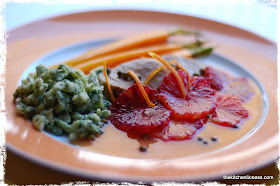The second cake that I am featuring in my series "Baking Cakes with Potatoes" is a so-called Potato Crumb Cake with Cherry Jam (Kartoffel-Krümel-Kuchen mit Kirschmarmelade). A delightful cake, perfect with that afternoon cup of tea or coffee. This simple cake certainly has that "old world charm" that I like so much in my baking.
Recipe for the Potato Crumb Cake with Cherry Jam
(Kartoffel-Krümel-Kuchen mit Kirschmarmelade)
Ingredients for the Crumb Cake
- 300 grams (10.5 ounces) plain/AP flour
- 2 ½ tsps baking powder
- 125 grams (4.4 ounces) waxy (russet) potatoes - cook the potatoes with the peel on.in unsalted water, let them cool, then peel and grate them on the small grates of your box grater. Or peel the potatoes while they are stiill warm and push them through a potato ricer and then let them cool them completely.
- 50 grams (1.7 ounces) old-fashioned oats
- 150 grams (5.2 ounces) superfine white sugar
- 1 egg (L), preferably free range or organic, room temperature
- 2 tsps of homemade vanilla sugar (you can also use 1 package pure vanilla sugar or 2 tsps pure vanilla extract instead)
- one pinch fine salt (I used fine sea salt)
- 75 grams (2.6 ounces) unsalted butter, room temperature
- a few tablespoons cherry jam or any other jam of your choosing (preferably homemade)
- a bit of dark rum (optional)
- a bit of powdered sugar for dusting (optional)
Equipment
- one 26 or 28 centimeter (10- or 11- inch) round springform pan
- unbleached parchment paper
- pastry brush
Preparation of the Crumb Cake
- Preheat your oven to 180 degrees Celsius.
- Butter the springform pan, line with unbleached parchment paper, butter and flour parchment paper, knocking out any excess flour.
- In a large bowl, either using your hand mixer or a pastry cutter, mix together all of the ingredients just until they come together as a crumb mixture.
- Take half the crumb mixture and put it into the springform pan in an even layer a possible. Press lightly to even out the crumbs a bit.
- With an offset spatula spread the jam on the crumb mixture. NOTE: you can add a bit of dark rum to the jam and heat it slightly before you spread it on the crumb mixture.
- Cover the jam layer with the remaining crumb mixture.
- Bake for about forty minutes, transfer to a cooling rack and cool completely before slicing. You can also dust the baked cake with a bit of powdered sugar before serving.
Serving some lightly whipped cream would be wonderful with this cake. As the Potato-Raisin Gugelhupf, this cake can be stored for a few days, just make sure to wrap it well.
Sources:
- Round springform pans from "Kaiser" (http://www. springform-pan.kaiserbakeware.com)
- Cake plate and dessert plates from "Bunzlau Pottery" (http://www.ceramicboleslawiec.com)
- Cake forks from "Butlers" (http://www.butlers.de)
**********************************************
Baking Cakes with Potatoes I - Potato-Raisin Gugelhupf
Baking Cakes with Potatoes II - Potato Crumb Cake with Cherry Jam
Baking Cakes with Potatoes III - Potato-Lemon Cake














































